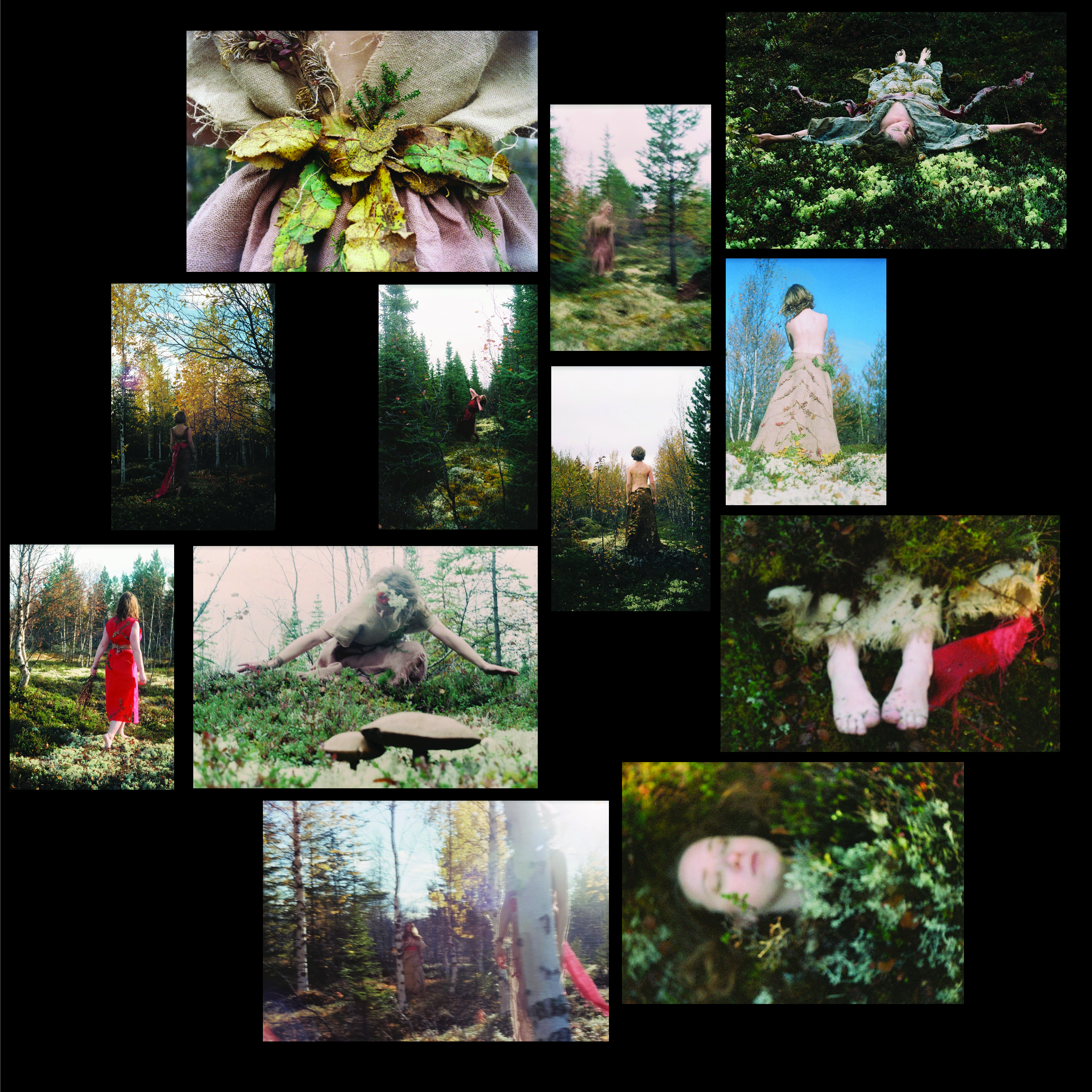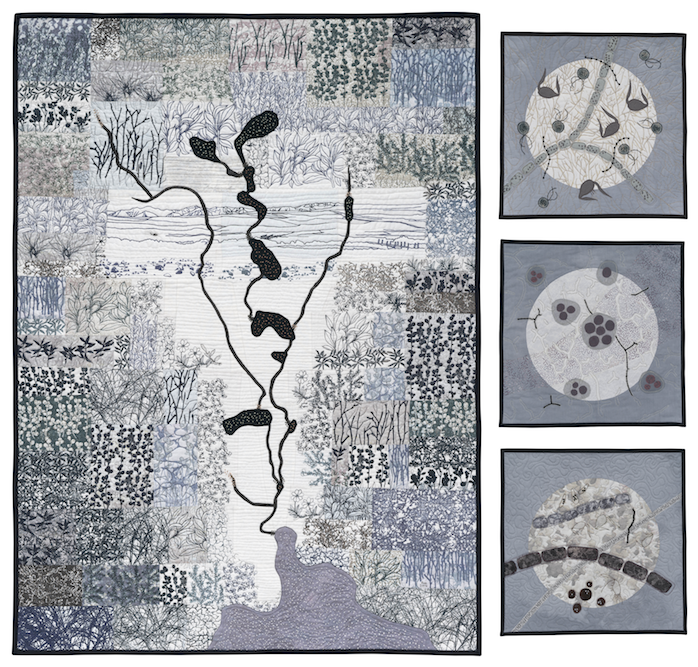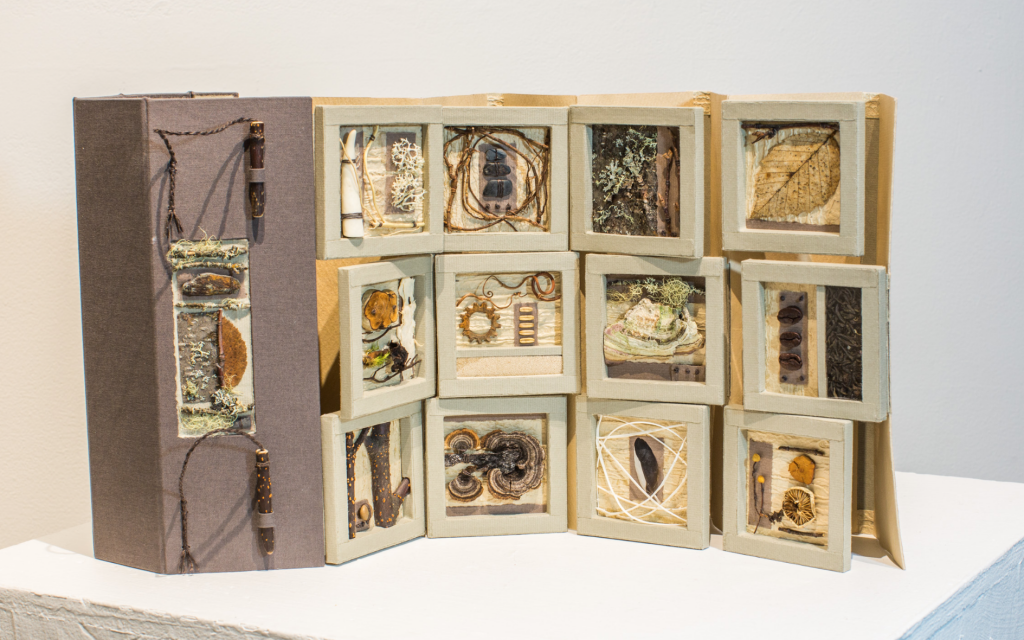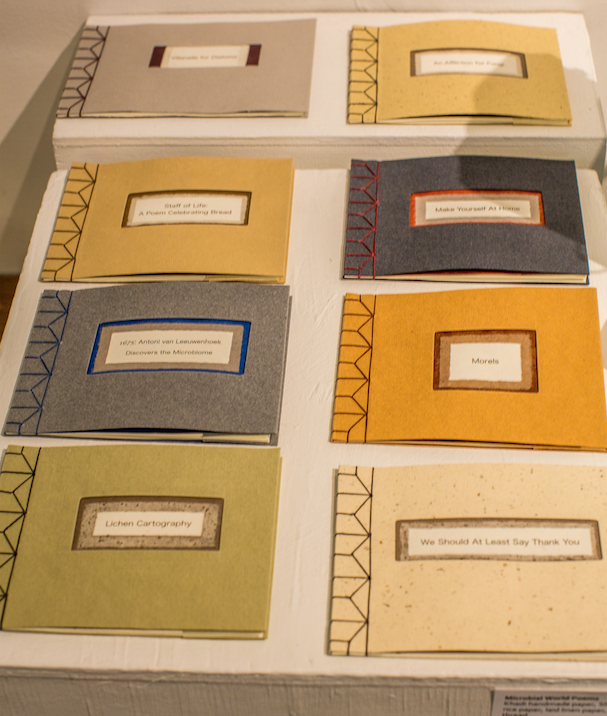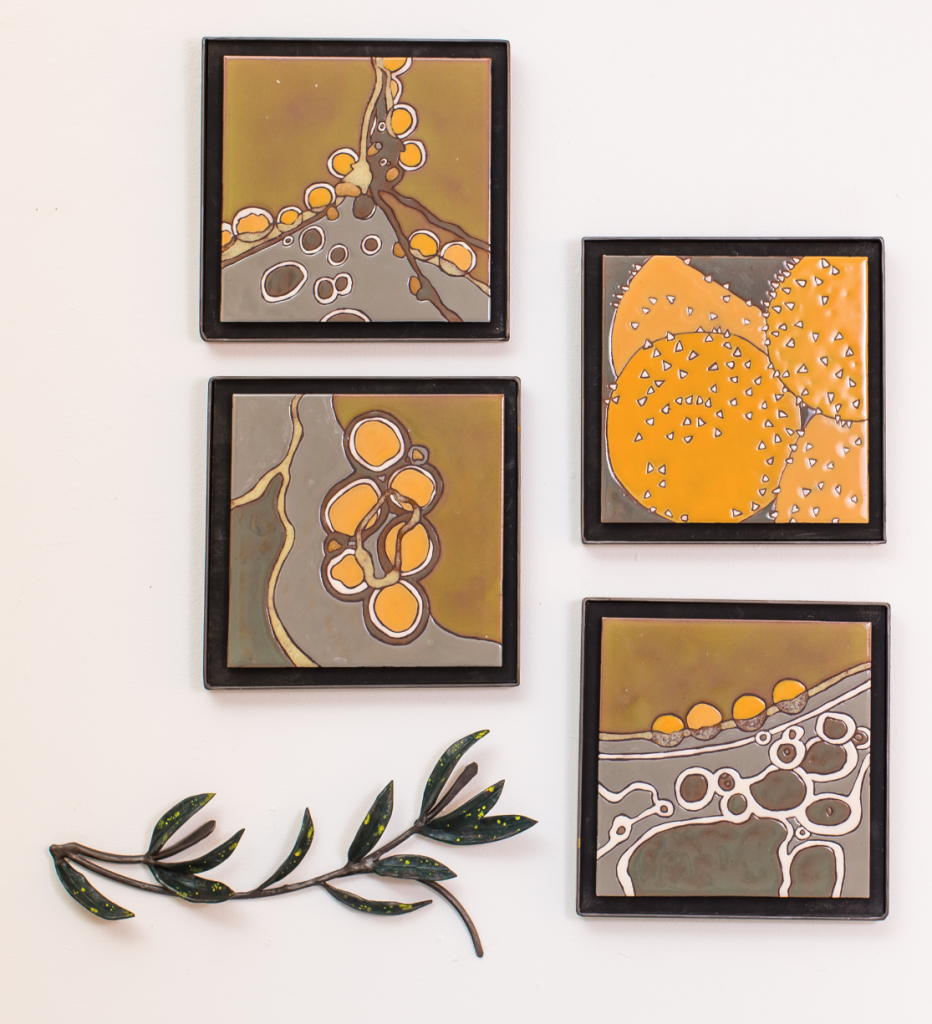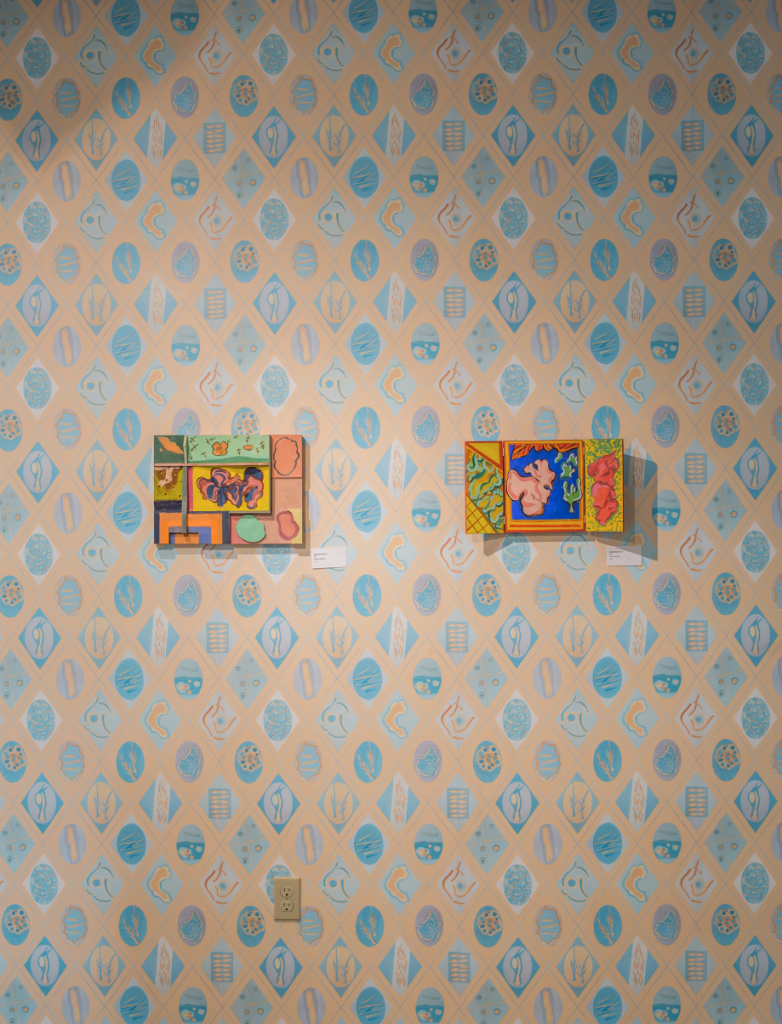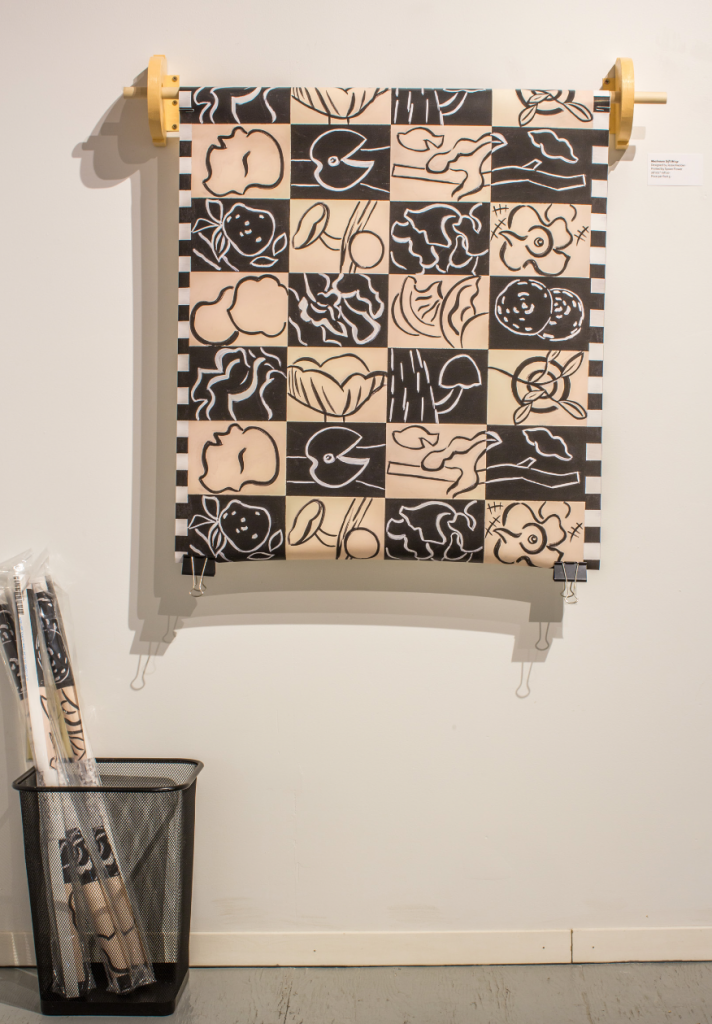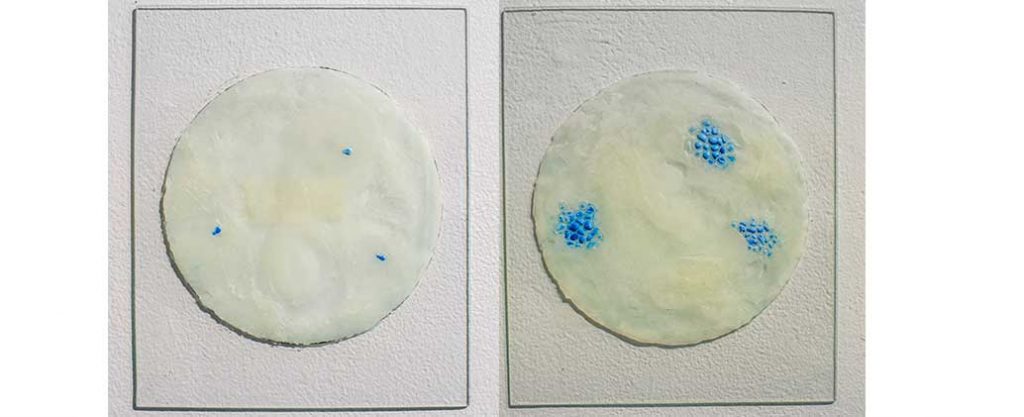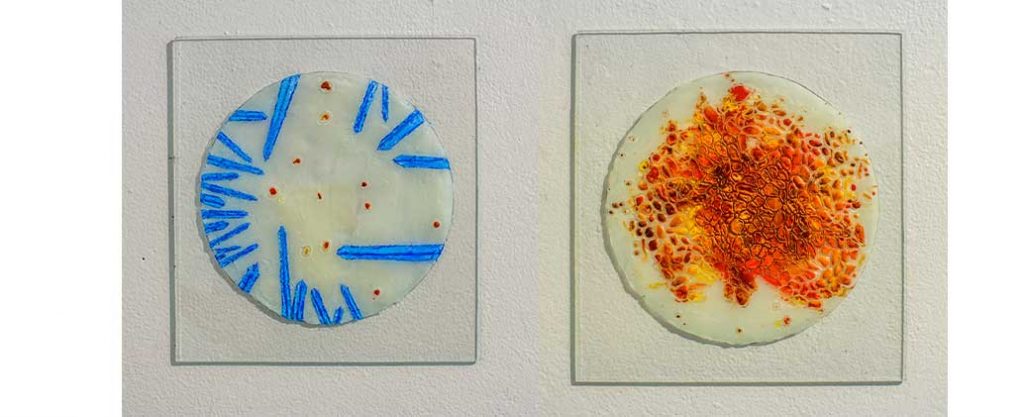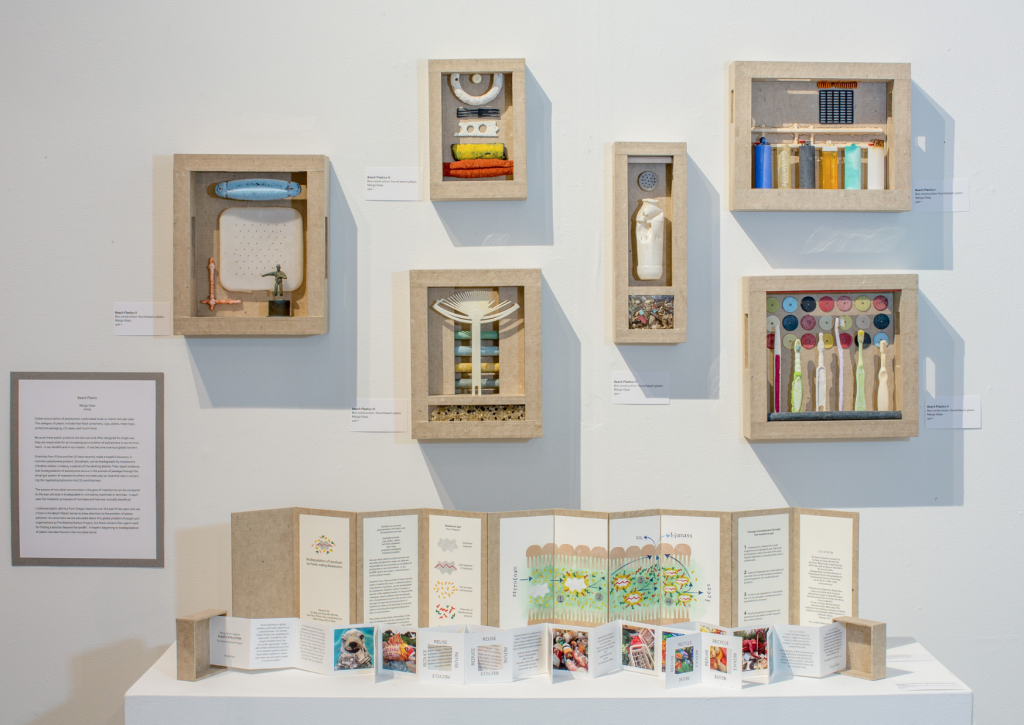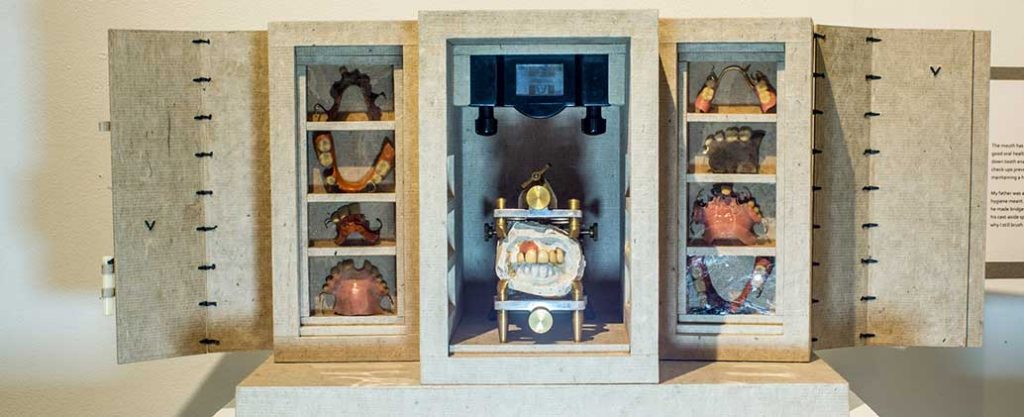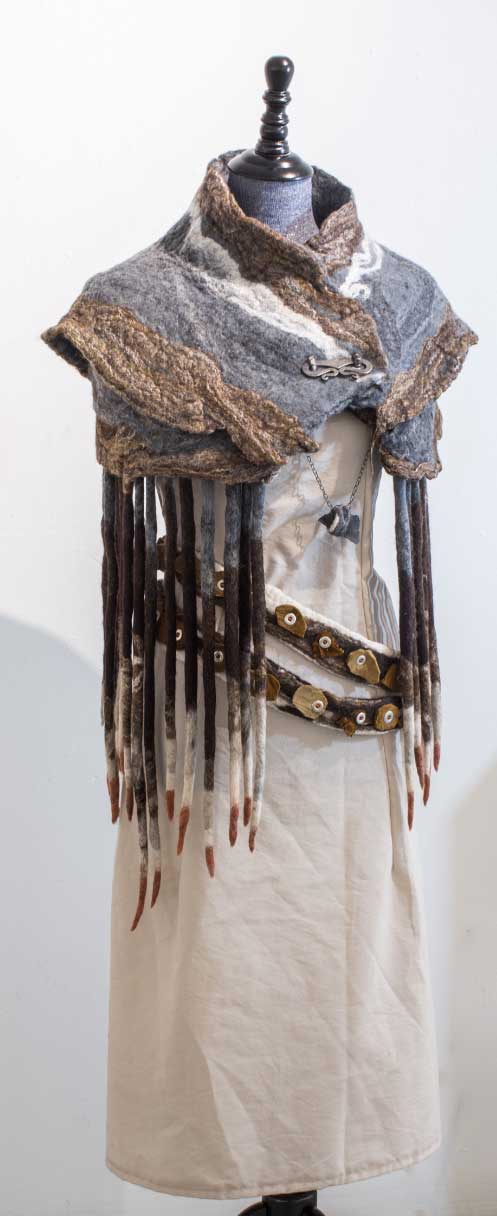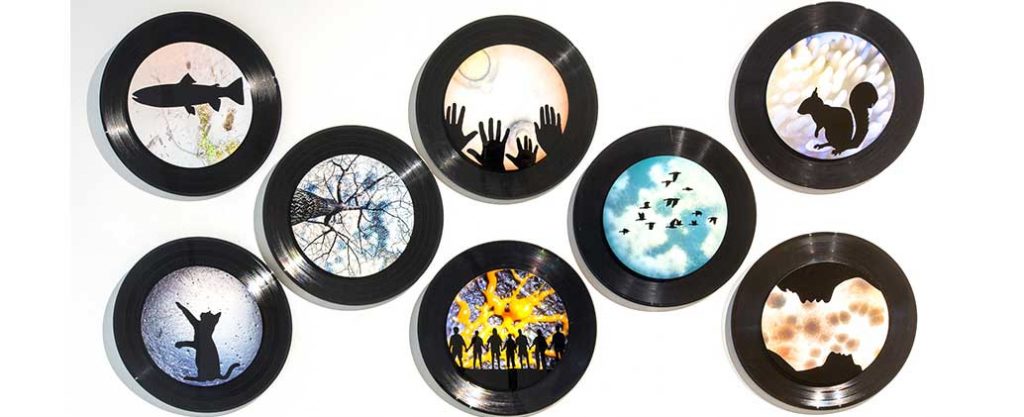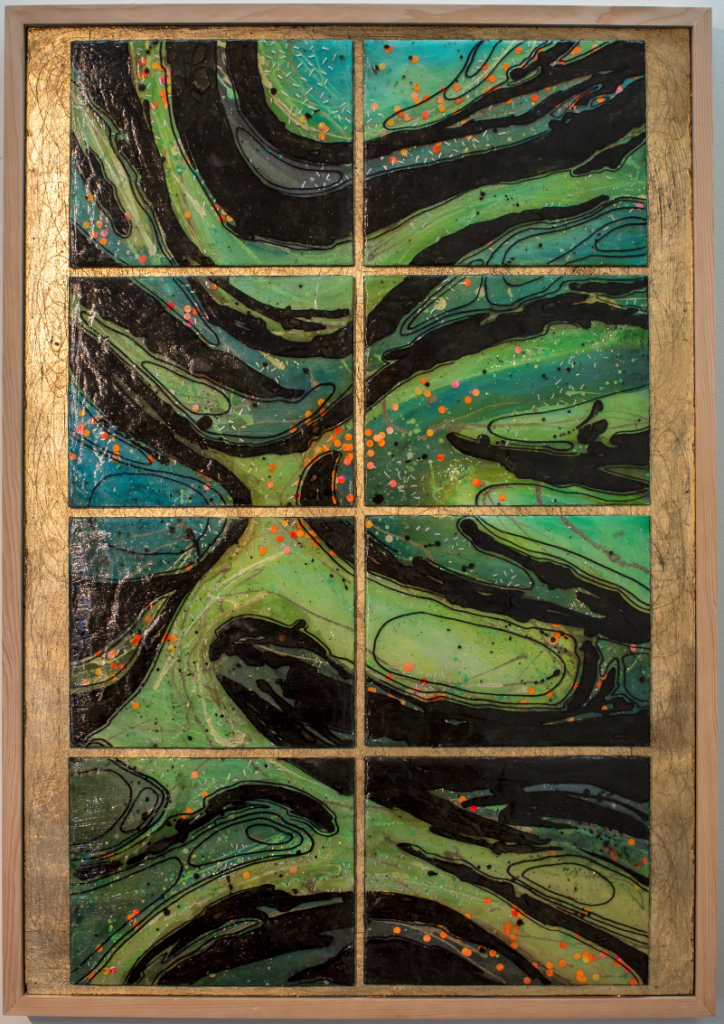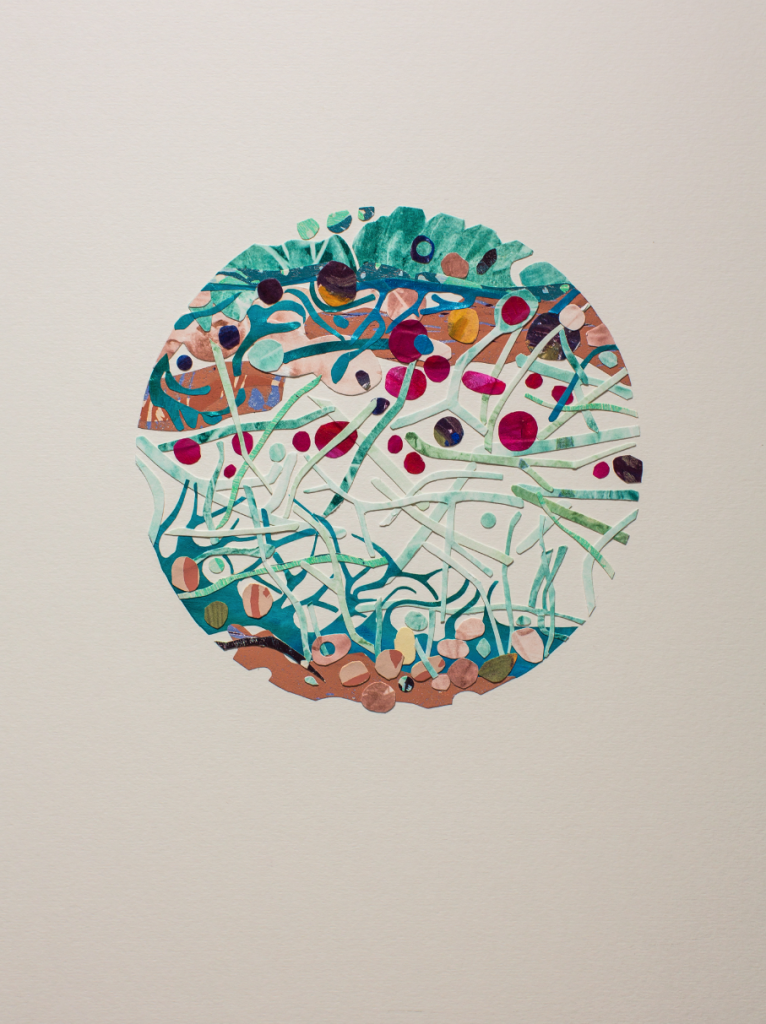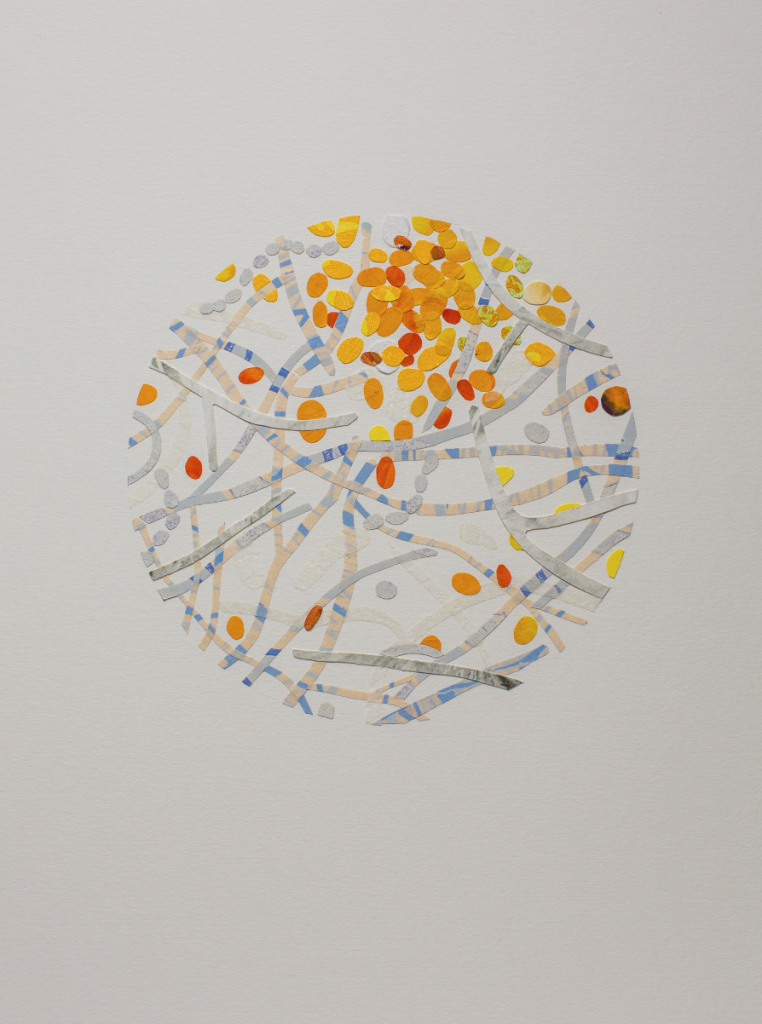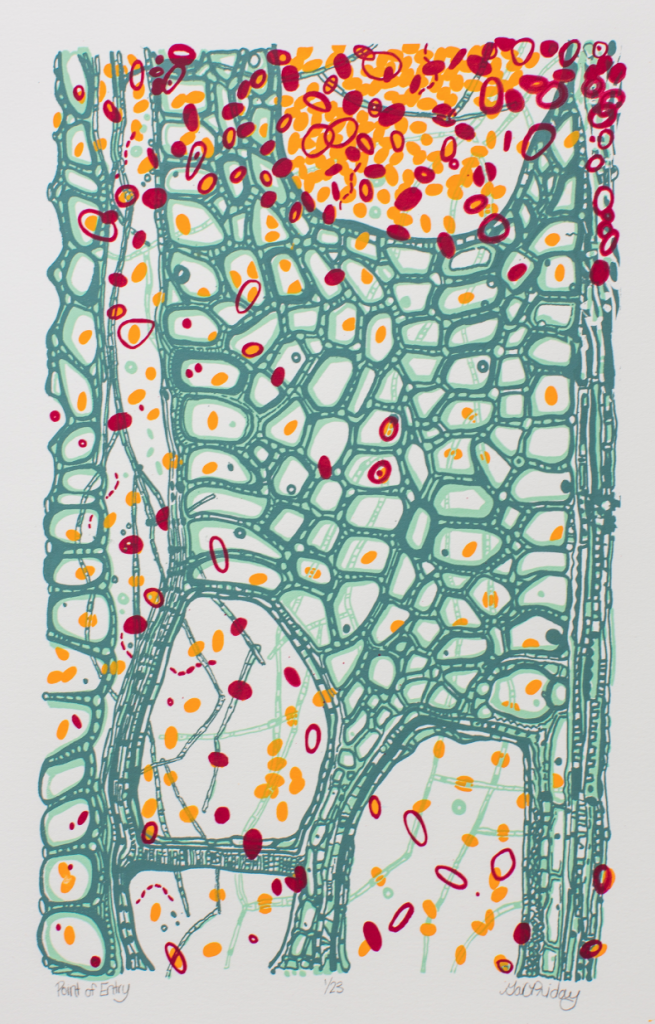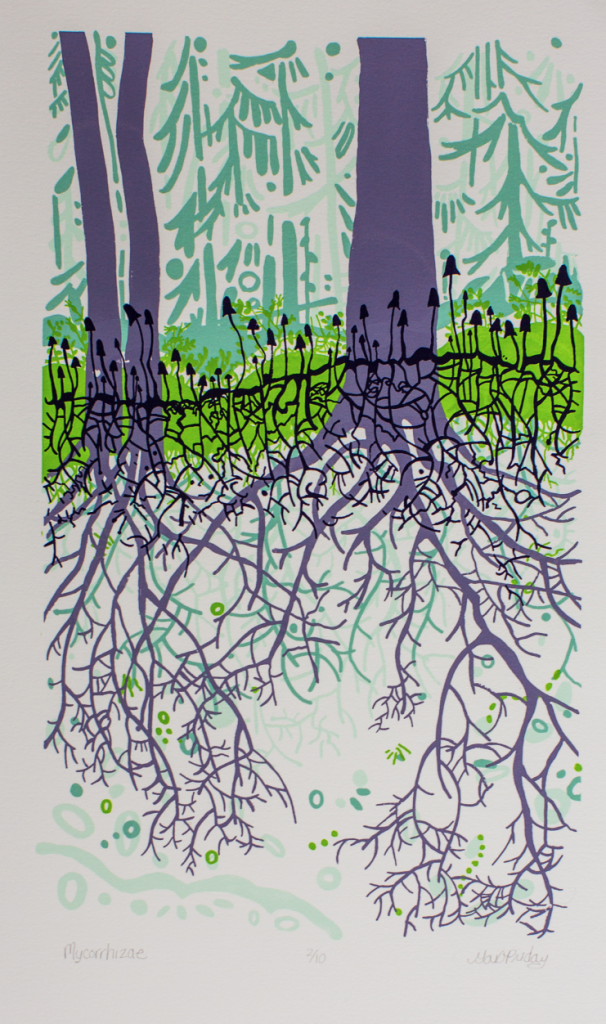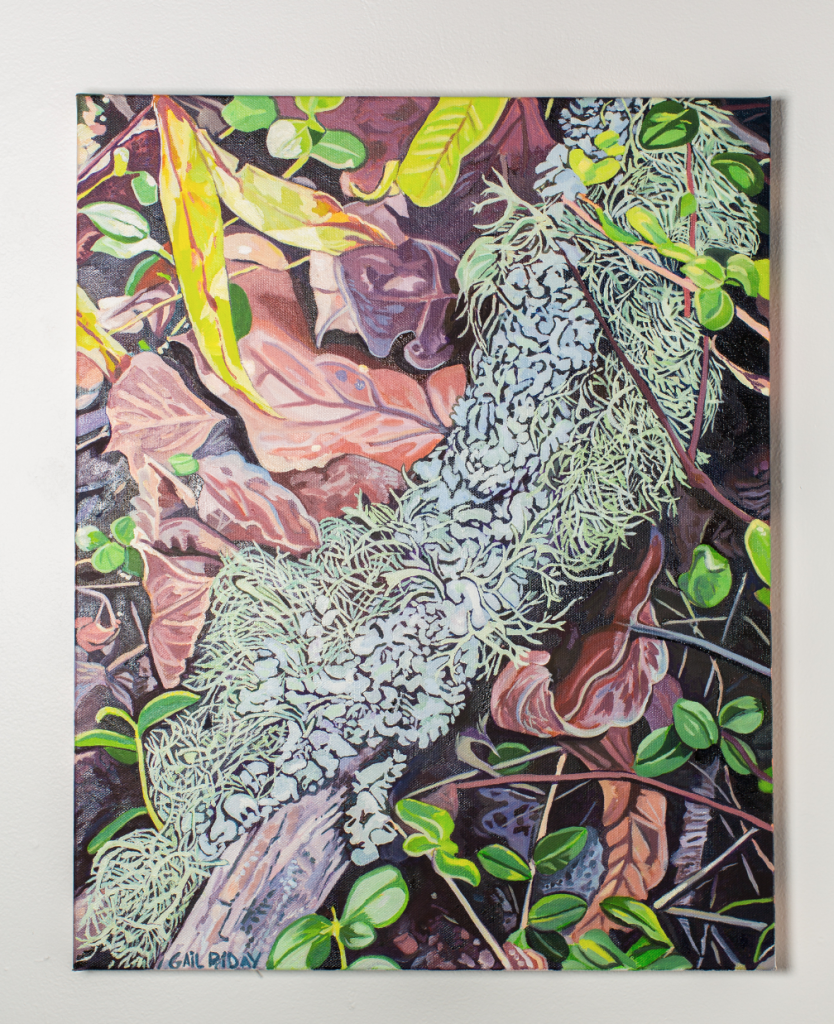Charlotte Bird
Mysterious Underground Collaboration: Mysterious Underground, Mycorrhizae
Charlotte Bird
Fiber Art: Quilts
birdworks-fiberarts.com
Ree Nancarrow
Fiber Art: Quilts
reenancarrow.com
We worked as a team on the Microbial Worlds project. Charlotte developed Mysterious Underground as a focus quilt, and Ree responded with Mycorrhizae. One of our first study articles was Fungal roles in soil ecology: Underground Networking by Whitfield (2007; Nature 449:136-138). It told stories about symbiotic relationships between fungi and vascular plants in coastal and boreal forests. Charlotte stayed hooked on fungi throughout the ITOC: Microbial Worlds project.We took Gary Laursen’s mycology field course in Denali National Park, hosted by Alaska Geographic. The class collected and identified over 100 species. We made spore prints, dissected samples, and studied the role of fungi in mediating many energy transformation processes vital to life. That study included parasitism, symbiosis, decay, and fungi as food for insects, birds, and small mammals. Charlotte resolved that the core of her lead piece would be images of the underground world of fungi. Dr. Laursen provided valuable clarification of relationships of fungi and vascular plants. He also confirmed that we had our mushrooms and mycorrhizae in the right habitats.While Charlotte focused on the mystery of the visible underground, Ree looked at the mysterious microscopic relationship between mycorrhizae and roots.This was a difficult piece to visualize. We can’t see underground. We see only gross remains of what is underground when edges are exposed. There are few conventions in art for depicting the underground. We worked to translate scientific text and journal drawing into images that are art, not classroom posters.
Toolik Chain of Lakes Collaboration
Toolik Chain of Lakes
Ree Nancarrow, Artist
Microbes 1, 2, and 3
Charotte Bird, Artist
We joined Jason Dobkowski collecting specimens during our Toolik Lake field trip. Jason helped Ree find the article Biogeography of Bacterioplankton in Lakes and Streams of an Arctic Tundra Catchment by Byron C. Crump, et al. (2007; Ecology, 88:1365-1378), which guided this piece. Jason answered Ree’s questions to ensure the piece would be as scientifically accurate as possible.
For Ree, studying the microbial world changed how she looks at a landscape: “Instead of thinking of the Arctic habitat as just vascular plants, I also think of the associated invisible microbial world. Much of area to the south of the field camp drains into a single stream and one small lake, while another part drains through a series of many small lakes. The study area interested me visually, but I was also curious about how the drainage characteristics change the microscopic inhabitants.’
We watched the scientists who study different bacterioplankton communities that thrive in separate parts of the beaded stream. In Toolik Chain, the communities show subtly as differently colored French knots. Toolik Lake, the catchment basin, has its own unique community, depicted with French knots of yet another color.
Charlotte used images of microbes–five distinct groups–that we collected in water column samples. The scientists found that many of the microbial DNA profiles are not from known organisms.
Susan Campbell
Susan Campbell
Poetry and Artist Books
Evidence
Early in my investigations for ITOC: Microbial Worlds, I was astonished to learn how ubiquitous and vital microbes are to the existence and expansion of life on Earth. It was a startling realization when I absorbed the fact that without microbes there would be no flora and fauna. We simply would not be here. Nothing in our living world could exist without microbes and the unique and unusual partnerships they form. I began to look at the world around me with fresh eyes. Hiking the Skarland Trail took on new fascination as I became cognizant of the complex life-force of microbes working on, in, beneath, and around everything. I was also intrigued to learn about the necessity of microbes in the production of common accoutrements of our daily lives: coffee, tea, wine, beer, bread, yogurt, chocolate, vanilla, cheese.
For this specimen book, Evidence, I wanted to articulate my sense of wonder through the focused arrangement of microbial artifacts. I gathered most of the objects from the boreal forest around Fairbanks, a few from the tundra, and some from daily life, each one representing the existence and necessity of microbes. From the forest, you see lichen, fungi, moss, leaf mold, alder roots and birch twigs, scoured bird bones and a feather. From the tundra, a bit of caribou antler and reindeer lichen. Other common objects include coffee, tea, yeast, grains of wheat, a twisted grape vine, and a tiny rusted cog. All exist because of the amazing interactions of microbes.
Poems
Inspiration for this poetry, focused on the wonder and science of microbes, came from ITOC field trips and scientific presentations that kindled my curiosity and propelled me to read voraciously. I plumbed scientific articles, nonfiction literature, field guides, and historical biographies to learn about microbial science. An August field trip to Toolik Field Station was influential. Necklaces of diatoms strung across microscope slides from a water sample I collected prompted me to find out more about the science behind this beauty and Villanelle for Diatoms was the result. Lichen-covered rocks in Atigun Gorge, along with the book Land of Extremes: A Natural History of the Arctic North Slope of Alaska, fueled Lichen Cartography. Dr. Gary Laursen’s enthusiasm for fungi was infectious while we collected mushrooms on the UAF trails in September. My idea for Morels blossomed on that hike and his book, Common Interior Alaska Cryptogams, was the source for An Affliction for Fungi: A Found Poem.
My curiosity stretched beyond Alaska. I knew a bit about Antoni van Leeuwenhoek, but it wasn’t until I read Eye of the Beholder by Laura Snyder that I understood how he revolutionized the way we see the world. Ed Yong’s book, I Contain Multitudes: The Microbes Within Us and a Grander View of Life, was an invaluable resource that inspired We Should at Least Say Thank You and was the source for Make Yourself At Home: A Found Poem. A chapter in Michael Pollan’s book, Cooked, gave rise to Staff of Life.
Debbie Clarke Moderow
Debbie Clarke Moderow
Author: Memoir and Creative Nonfiction
debbieclarkemoderow.com
The Narrow Line: Where Art Meets Science
The extraordinary ITOC collaborations between artists and scientists, fostered by microbial ecologist Mary Beth Leigh, inspired this essay.
During a visit in July to the Bonanza Creek Experimental Forest, we followed ecologists Teresa Hollingsworth and Roger Ruess and site manager Jamie Hollingsworth along a boardwalk over a fen, where they explained studies measuring carbon dioxide and methane productivity from plants, water, and soil. That was my first amble along a “narrow line’ with scientists. It would not be my last.
At the Arctic’s Toolik Field Station, ecologist Donie Bret-Harte led us alongside a different boardwalk, explaining studies simulating different climates in order to predict greenhouse gas emissions. Ecologist Jason Dobkowski loaded our group into boats so we could accompany his crew as they collected water samples from Toolik Lake, relating to carbon and methane productivity. Naturalist Seth Beaudreault spoke about the Arctic’s migratory birds and their challenges in this time of warming.
I returned from Toolik Field Station engaged in a new way of thinking about our warming land. Two months later, I followed aquatic ecosytem ecologist Katey Walter Anthony onto thin ice of a lake outside of Fairbanks, as she tended to her methane studies.
From the first day of this program forward, microbial ecologist Mary Beth Leigh mentored my growing awareness in microbial science. For her generosity in sharing her scientific wisdom and her encouragement of art-science collaboration, I will long be grateful.
Download The Narrow Line (PDF)
Deceptive Beauty
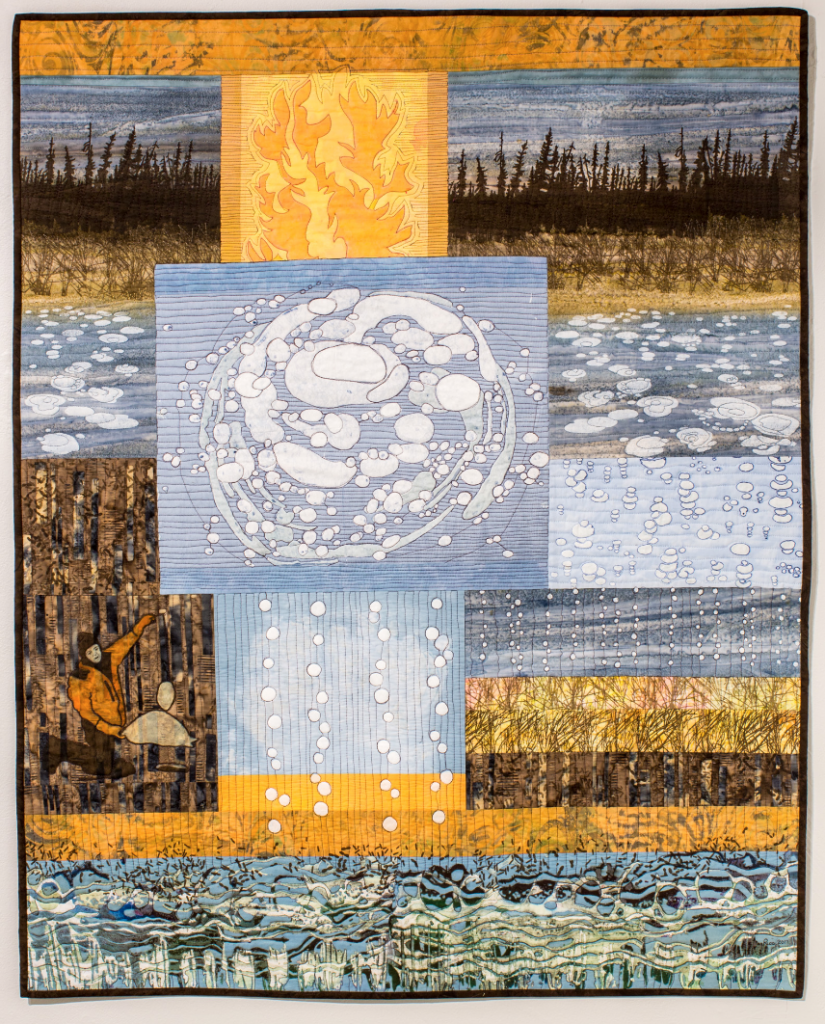
Ree Nancarrow, Artist
In collaboration with Debbie Clarke Moderow, Writer
We were honored to accompany Katey Walter Anthony, aquatic ecosystem ecologist, as she tended to her methane studies on a frozen lake outside of Fairbanks in October.
Katey is a research professor for the University of Alaska Fairbanks Water and Environmental Research Center. Her research centers on the emission of the greenhouse gases methane and carbon dioxide triggered by permafrost thaw.
While much has been said about the role played by carbon dioxide in our warming atmosphere, the effects of natural methane production are less well known. Thawing permafrost contributes to both the warming of existing lakes and the creation of new ones. On the bottom of these lakes and ponds, in oxygen-free conditions, bacteria feed on decomposed plant matter long frozen in the permafrost, producing methane that bubbles to the surface. In winter this production of methane continues–bubbles freeze in layers as lake ice thickens. Methane is recognized as 25 times more potent than carbon dioxide, molecule to molecule, as a greenhouse gas.
In her methane studies, Katey seeks to better understand the origins of increased methane emissions from northern lakes and ponds and how ecosystems might respond, and in turn, impact global environmental change.
Stephanie Rae Dixon & Mary Beth Leigh
De:composition
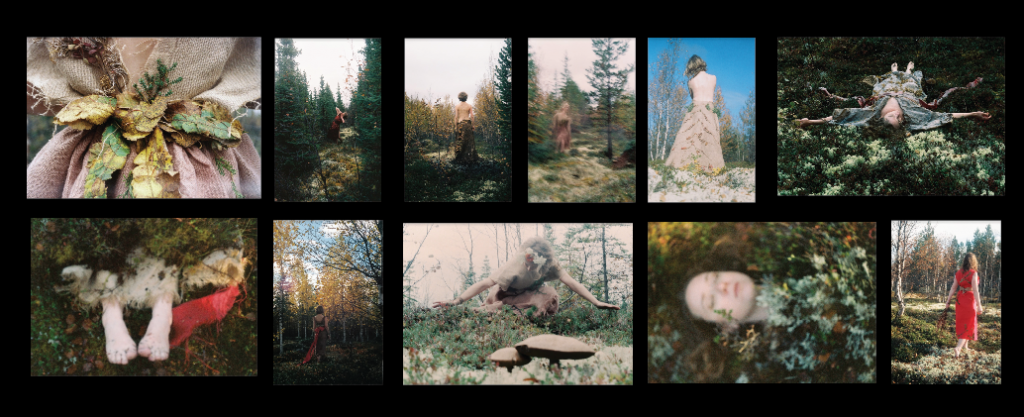 Stephanie Rae Dixon
Stephanie Rae Dixon
Costumer, Multi Media Artist (Brooklyn, NY)
stephanieraedixon.com
Mary Beth Leigh
Associate Professor of Microbiology (University of Alaska Fairbanks)
Faculty website
Microbes keep the global carbon and nutrient cycles turning by decomposing billions of tons of dead plant material per year. Decomposition rates are controlled partially by the array of natural chemicals present in different plants. Chemicals that discourage animals from eating plants can slow down some decomposers but can stimulate other microbes, including some that eat toxic environmental pollutants.
Our team collaborated over the course of 3 field seasons on a decomposition study in an experimental tree garden at Kevo Subarctic Research Station in Northern Finland. Trees from around the circumpolar North, including birch trees with different chemistries, were planted over 30 years ago in the gardens at Kevo. This provided an excellent opportunity to investigate how plant chemistry affects decomposition and to study the microbes involved while controlling for environmental variables.
We studied decomposition using buried litter bags, which consist of mesh bags containing a known quantity of leaves or stems that are buried and then later retrieved for analysis. We then re-weighed the contents to determine how much had decomposed after 1 and 2 years of burial. Because only 1% of microbes can be cultured in the laboratory, we used DNA analysis to identify the diverse array of bacteria, fungi, and other microbes associated with the decomposing plant litter.
In this collaborative project, we wove together artistic and scientific methodologies. Stephanie assisted with all aspects of the field research and then created dresses that the scientific team collaboratively adorned with plant biomass from the garden. Following photo and video shoots of Mary Beth and postdoctoral researcher Mary-Cathrine Leewis wearing the dresses, they were subjected to burial in parallel with the litter bags. Dresses were exhumed after 1 and 2 years for repeat photo and video shoots and for microbial DNA analyses. Scientists were exhumed considerably sooner.
De:composition is a multimedia installation that attempts to recreate the environment of the experimental garden that served as an incubator for our art-science collaboration.
Collaborators
- Mary-Cathrine Leewis (UAF) — art subject, field researcher
- Ellis Traver (Brooklyn, NY) — soundscape
- Jessica Schoen (Brooklyn, NY) — film editor
- Eric Henderson (UAF) — fabricator
- Tamora Petitt (Brooklyn, NY) — dancer (opening night)
- Devin Drown, Eric Collins, Ian Herriot, Eric Henderson, and Ursel Schütte (UAF) — DNA analyses
Acknowledgements
Made possible by a grant to MBL from the National Science Foundation
(DEB-1257424). Support for DNA analysis through grants to Eric Collins from the National Oceanographic and Atmospheric Administration and to Devin Drown from the Alaska Biomedical Learning and Student Training (BLaST) Program and the Alaska IDeA Network of Biomedical Research Excellence. Additional assistance provided by the UAF DNA Core Lab Geophysical Institute Machine Shop. Special thanks to Elina Vainio and the staff of Kevo Subarctic Research Station.
Annie Duffy
Annie Duffy
Painting, Sculpture, and Mixed Media
annieduffy.com
 I was initially interested in the “Microbial Worlds’ project because of my fascination with the unseen, or invisible, world, which has been a longstanding thread throughout my body of work. Over nearly a year and half of intensive collaborative work with both an array of scientists and other artists, I found it quite difficult to narrow my interests in what I learned to a few concise ideas — the Microbial World has far too many fascinating facets. I found the field of microbiology to be endlessly intriguing.
I was initially interested in the “Microbial Worlds’ project because of my fascination with the unseen, or invisible, world, which has been a longstanding thread throughout my body of work. Over nearly a year and half of intensive collaborative work with both an array of scientists and other artists, I found it quite difficult to narrow my interests in what I learned to a few concise ideas — the Microbial World has far too many fascinating facets. I found the field of microbiology to be endlessly intriguing.
Ultimately, I decided to make pieces that fit within my own aesthetic realm but moved a step further forward in complexity to incorporate microbial imagery related to the Circumpolar North. I became quite fond of the idea of representing the Arctic, and Subarctic, landscape through imagery based upon what would normally be invisible to the naked eye. Specifically, the imagery I used in this series was based upon samples collected at Toolik Field Station that were used to uncover buried Arctic carbon. I quite liked the idea of examining carbon based life from another perspective. There is a metaphorical symmetry there I find quite compelling.
While I still feel to be very much a novice in the field, I have developed a much greater understanding of the world around me and an appreciation of the microbiome that certainly did not have before. This process of the ITOC seminars and field trips, discussions with scientists and fellow artists, truly shifted my perspective on what my concept of biological life was and has given me a great deal of ideas to work with moving forward. This ITOC journey has been incredibly rewarding.
Nancy Hausle-Johnson
Nancy Hausle-Johnson
Tile Artist
alaskatileart.com
EMERGENCE: The Warming Climate is Waking Up Sleeping Microbes
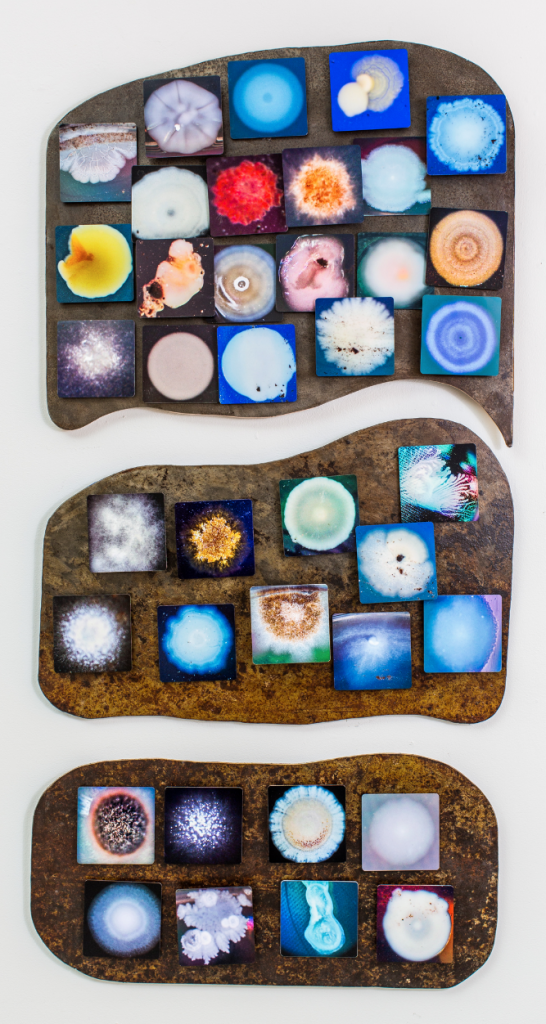
Statement by Robyn A. Barbato, Research Scientist, U.S. Army Corps of Engineers Cold Regions Research and Engineering Laboratory, New Hampshire
Soil is teeming with living organisms, with as much as one billion bacterial cells in merely one gram (about the size of a pen cap)! These soil microorganisms cycle nutrients and make them available to larger organisms, often making the ecosystem stronger. Permafrost (soil that is frozen for two consecutive years) is very special because it serves as a time capsule of biological and geochemical materials, representing the ecosystem from the time that the soil froze. In fact, the time period from 15,000 to 45,000 years before the present is represented just down the road from Fairbanks at the CRREL Permafrost Tunnel! Unfortunately, the time capsule is shrinking, as the warming climate is causing permafrost to thaw. When permafrost thaws, microorganisms that were once inactive become active and begin cycling nutrients. If the permafrost thaws according to the climate predictions, this could result in an increased emission of carbon dioxide and methane, a depletion of soil carbon, and the release of potentially harmful microorganisms. This art represents the emergence of dominant microbes during permafrost thaw. Bacterial and fungal colonies were cultivated from three stages of permafrost thaw: no thaw (frozen), minimum thaw, and maximum thaw. As you can see, the diversity and magnitude of microbial growth increased during the stages of thaw. These newly active microbes will likely impact the flux of nutrients in the ecosystem. By studying which microbes will activate during permafrost thaw, we could predict the dominant processes that will influence larger organisms like plants and animals.
Arctic Willow Under Stress
Inspired by the work of Robert Blanchette, Scientist-Professor, University of Minnesota
Statement by Robert Blanchette, Scientist-Professor, University of Minnesota
Willows (Salix species) are one of the most important plant species in the Arctic ecosystem. A disease caused by a biotrophic rust fungus called Melamspora attacks willow, causing the trees to decline and die. The disease appears to be on the rise in the Arctic and is getting more serious, possibly due to climate change and a warming Arctic. Although most rust diseases we hear about attack food crops like wheat, this Arctic rust prefers trees for a host. Nancy Hausle-Johnson reveals the unseen world of willow rust in her art showing its microscopic characteristics and exposing details of the pathogen and its unusual spores. Wind spreads the spores and then this killer parasite invades new trees. If we can gain a better understanding of the biology and ecology of this pathogen, it will lead the way to finding methods to control its spread.
Jessie Hedden
Jessie Hedden
Painting
jessiehedden.com
Microbes are everywhere!
Worship the all mighty microbe!
Wallpaper seemed like the perfect way to express the ubiquity of microbes in our environment while also expressing their invisibility both literally and figuratively as something we, until recently, have ignored, devalued or misunderstood. For upwards of nine months, a side table in my kitchen supported a small microbiology lab where I cultivated and observed a multitude of microscopic organisms that later inspired the forms in the wallpaper design. The palette was chosen for its pleasing, visual subtlety blending into one’s surroundings while surprising the viewer at closer inspection with a variety of strange, unfamiliar forms.
Microbes occupy and thrive in every corner of the earth and outnumber human cells in our bodies 10 to 1. Human Microbiome, Microbial Cloud, and Symbiosis are terms referring to communities of microbes we now know are key to maintaining a healthy body and environment. Take away some of the microbes in the human gut and our ability to digest properly falters. Trees rely on the subterranean network of hair-like fungal filaments, known as “mycelium’, to collect nutrients from the soil and in turn provide the fungi with sugar generated via photosynthesis.
Microbes are worthy of our devotion like religious icons. With this idea in mind I created a small series of vibrantly colored, icon-like paintings visually inspired by the mushrooms and fungi surrounding my house. I took great delight for several weeks this past fall photographing, drawing and painting all the “fruiting bodies’ I could find. Sitting on the ground, I studied the mushroom as one would a face, with all of its peculiar details, as well as the particularities of light on the forest floor. In the studio, these naturalistic field paintings gave way to a vibrant palette and emphasis on pattern and texture when combined with a variety of media and my interest in early Ethiopian icons. In many non-western cultures the use of mushroom imagery in art is thought to bring good luck and health to the possessor.
My involvement in this project has greatly deepened my understanding of the role microbes play in all aspects of our lives. It has also lead to interesting developments in my work as an artist. Special thanks to Robert Blanchette (University of Minnesota), Virginia Walker (Queen’s University), Gary Laursen (University of Alaska and the High Latitude Mycological Research Institute), and Mary Beth Leigh (University of Alaska Fairbanks).
Mariah Henderson & Eric Henderson
Mariah Henderson
Painting, Mixed Media
Eric Henderson
Artist and Biologist, Institute of Arctic Biology, University of Alaska Fairbanks
Veiled
Unveiled
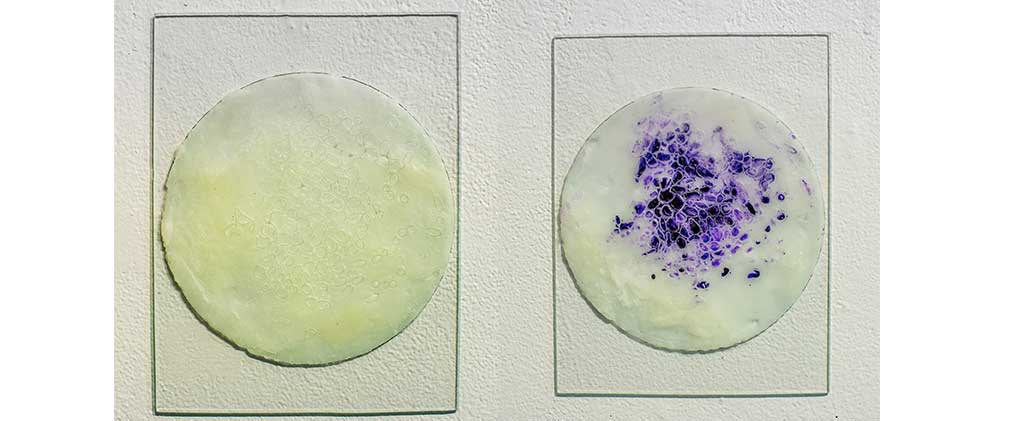
Despite the aid of a microscope, many microorganisms are still invisible; their transparent bodies are only clearly revealed with the use of specialized stains, such as crystal violet. The use of stain to view microbes that would be otherwise invisible allows scientists to unveil the veiled.
The Prokaryotes
When we think of life, we often think of the animals, plants, and fungi within the domain, Eukarya. However, eukaryotes are not the most abundant or diverse taxon on Earth. There are two other domains containing very different single-celled life forms, Bacteria and Archaea. These two taxa are known as prokaryotes because their cells lack nuclei or other features that the larger and more complex eukaryotic cells contain. While we cannot see prokaryotes without a microscope, they are all around us, on us, and within us. Prokaryotes are far more diverse than animals or plants and are essential to all other forms of life.
The Prokaryotes visually represents the vast diversity of bacteria and archaea as well as their connectedness through evolution. The connecting lines represent evolutionary lineages through time that have led to the bacterial and archaeal species we share the planet with today.
Inoculation The 1%
Microbes can be grown by swabbing an object in the environment and then running the swab over a nutrient-rich gel known as agar in a Petri dish to inoculate it. Within a couple of days, colonies of microbes of various colors and textures will appear on the plate. Each of these colonies is composed of millions of microscopic bacterial or fungal cells, each which have spawned from a single cell deposited on the plate. Interestingly, less than 1% of bacterial species in the environment can be cultured in this way.
Inoculation and The 1% reference the dynamic growth of the colonies we observed during our culturing experiments.
Permafrost Warming
During the duration of this project we learned about the roles microorganisms play in the ecosystem, our health, and about our relationship with them. One of the most significant impacts humans and microorganisms have on each other is climate change. Through references of ice and hot-toned microbes, Permafrost and Warming shows the melting of permafrost due to air pollution with greenhouse gases and increased microbial activity. As permafrost thaws, frozen biomass becomes available for microbial consumption. Like us, many microorganisms, respire carbon dioxide, while others are able respire methane. Both methane and carbon dioxide are greenhouse gases that contributes to further global warming and permafrost thaw.
Margo Klass
Margo Klass
Box Constructions, Artist Books
margoklass.com
Beach Plastic
Global consumption of polystyrene is estimated to be 21 metric tons per year. This category of plastic includes fast food containers, cups, plates, meat trays, protective packaging, CD cases, and much more.
Because these plastic products are low cost and often designed for single use, they are responsible for an increasing accumulation of polystyrene in our environment in our landfills and in our oceans. It has become a serious global concern.
Scientists from China and the US have recently made a hopeful discovery: a common polystyrene product, Styrofoam, can be biodegraded by mealworms (Tenebrio molitor Linneaus, a species of the darkling beetle). They report evidence that biodegradation of polystyrene occurs in the process of passage through the larval gut system of mealworms where microbes play an essential role in converting the ingested polystyrene into CO2 and biomass.
The actions of microbial communities in the guts of mealworms can be compared to the way cellulose is biodegraded in ruminating mammals or termites. In each case the metabolic processes of microbes and host are mutually beneficial.
I collected plastic detritus from Oregon beaches over the past three years and use it here in the Beach Plastic Series to draw attention to the problem of plastic pollution. As consumers we are educated about this global problem through such organizations as The Washed Ashore Project, but there remains the urgent need for finding a solution beyond the landfill. A hopeful beginning to biodegradation of plastic has been found in the microbial world.
Specimen
The mouth has its own resident microbiome. Many of its microbes contribute to good oral health but the harmful ones convert sugar to acids, thereby breaking down tooth enamel and causing decay. Regular brushing, flossing, and dental check-ups prevent tooth decay and promote oral health. They are the keys to maintaining a healthy microbiome in your mouth.
My father was a dentist. I grew up all too aware of what negligence of oral hygiene meant. I often accompanied him to his laboratory and sat at his elbow as he made bridges, partials, and whole sets of false teeth for his patients. Some of his cast-aside specimens are used in this box construction. They are reminders of why I still brush my teeth at least five times a day.
New World
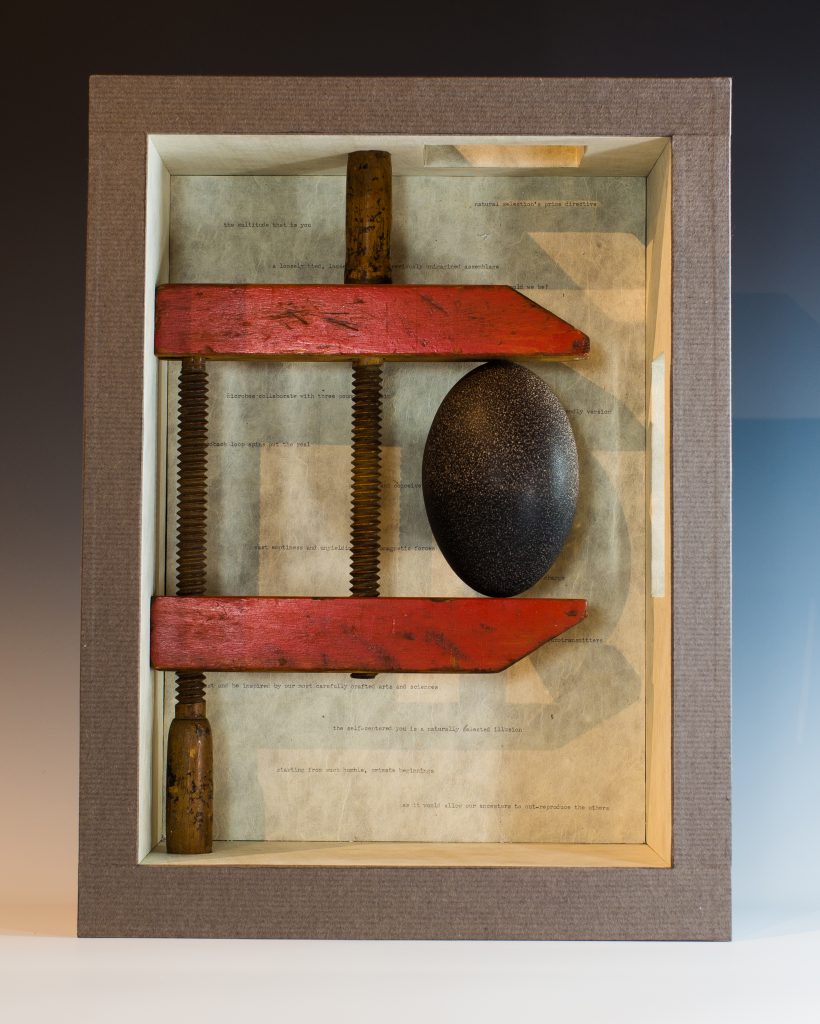
Margo Klass
Artist
Eduardo Wilner
Collaborating scientist and writer
Associate Professor of Philosophy, University of Alaska Fairbanks
“Know thyself,’ warned the Oracle of Deplhi. But we perceive and conceive the world through evolution-designed lenses. Unintelligent natural selection cannot design eyes that really see. We live in the virtual reality that allowed our ancestors to out-reproduce the others. So you’d better not trust your gut for anything besides ancient reproductive decisions. Because the real is so, so far from the reproductive-friendly movie that natural selection made for us. “Solidity’ turns out to be vast emptiness and unyielding electro-magnetic forces. And you, your-self, turn out to be more like a travelling circus, with no one self in charge. The multitude that is you is spelled out in a recipe made by 10 million microbial genes and 23 thousand human ones. Six pounds of bacteria collaborate with 3 pounds of brain in the production of behavior-changing neurotransmitters. The self, centered you is a naturally selected illusion. You are a loosely tied, loosely defined, previously unimaginable assemblage. I is really we.
So how should the we that is you, and the we that is us navigate this complicated new world? Not by following the naturally selected movie running in our heads. Let us intelligently design our reality detector, searchlight, and compass. Let the feedback loop between the sciences and the arts spin out the real. Let us move on from our humble, primate beginnings.
Jennifer Moss
Jennifer Moss
Painting, Digital Art
jmossart.com
https://www.jmossart.com/microbes.html
Magic Fungus Wrap
Fungi, although they can grow in aggregates of very large size, are considered to be microorganisms due to the ability of their cells to live independently.
Fomes fomentarius is known commonly as the tinder polymore, tinder fungus, hoof fungus and tinder conk. It is a common plant parasite that lives on the bark of birch and beech trees throughout the world. It is an important component of the forest ecosystem because when a tree dies, it decomposes wood through a process known as white rot. Traditionally, people have used parts of this fungus for a wide variety of purposes including clothing, as a tobacco substitute, pin cushions, as a drying mechanism for fly fishing, mounting insects, starting fires, and in rituals to clear evil spirits. It has been used medicinally as an anti-inflammatory, diuretic, laxative, calming tonic, to fight tuberculosis, for teeth drying in dentistry, and wound staunching during surgery. In Chinese medicine, it is used for the treatment of throat, stomach and uterine cancers. There have been recent studies that show bioactive substances extracted from Fomes fomentarius are successful anti-tumor agents. There may also be potential for it’s use to enhance circulation, regulate blood sugar and lower blood pressure.
‘Amadou’ is the layer useful for making tinder and for many of the purposes listed above. It is used by modern day wood crafters and was found in a fire starter kit on mummified human remains dating from around 3,300 BC. It is also currently used in Romanian folk art hat and purse making.
Ethnomycologist Robert Blanchette (University of Minnesota) was instrumental in my inspiration for this project, as was Mako Csaba, a traditional amadou hat maker in Romania. Thanks also to A Weaver’sYarn.
Interconnected
“When we try to pick out anything by itself, we find it hitched to everything else in the Universe.” ~John Muir
In this series I explore a few ideas and interconnections between microbial worlds and larger systems. We are all connected on this planet through the natural world and some of the primary components of those connections are those we cannot see unaided.
1. Invisible communication pathways:
Forests + spores collected from Arctic willow leaf fungus
2. Collaborative interactions: 1
Community + slime mold harvested on Ester Dome
3. Influences on human behavior (toxoplasmosis): Cat + bacteria grown from pet water sample
4. Global transport of microbes:
Migration + bacteria grown from dental floss after eating duck for dinner
5. Food security and forest decomposition:
Squirrel + gill detail from fungus from the boreal forest
6.Transmission of information:
Hands + bacteria grown from finger swab
7. Personal communications:
Humans + bacteria grown from underarm swab
8. Food web, water security, and climate change: Trout + zoo/phytoplankton from arctic lake samples
Water is Life
Over time, hydrocarbons, such as crude oil, are partially degraded by various species of bacteria that occur naturally in the environment. This was observed in the Deepwater Horizon spill in the Gulf of Mexico where a few ‘nutritionally diverse’ types of bacteria increased in population density in the spill area. Studies have shown that the bacterial communities present in warm waters vs. cold waters differ in species composition, abundance, and function, due to multiple environmental factors. As Alaska becomes more involved with offshore oil development, of particular interest to environmental regulators, industry, oil spill responders, the public, and other stakeholders is the viability of utilizing natural response mechanisms such as oil-eating bacteria and the potential benefits and risks of chemical dispersants to mitigate spill damage. While oil biodegradation does actively occur in Arctic waters, there are significant additional challenges not present elsewhere, such as extreme cold, winter storm activity, sea ice cover and it’s movement, and very remote locations, and cultural and subsistence uses of Arctic marine life that add greatly to the complexity of the issue.
This work explores biodegradation of Alaska crude oil in the Arctic Ocean by indigenous bacteria. Microbiologist Mary Beth Leigh and others, outlined in my extended statement, were instrumental in my inspiration and research of this topic. Special thanks to British Petroleum.
Ree Nancarrow
Ree Nancarrow
Fiber Art: Quilts
reenancarrow.com
Deceptive Beauty
In collaboration with Debbie Clarke Moderow, Writer
We were honored to accompany Katey Walter Anthony, aquatic ecosystem ecologist, as she tended to her methane studies on a frozen lake outside of Fairbanks in October.
Katey is a research professor for the University of Alaska Fairbanks Water and Environmental Research Center. Her research centers on the emission of the greenhouse gases methane and carbon dioxide triggered by permafrost thaw.
While much has been said about the role played by carbon dioxide in our warming atmosphere, the effects of natural methane production are less well known. Thawing permafrost contributes to both the warming of existing lakes and the creation of new ones. On the bottom of these lakes and ponds, in oxygen-free conditions, bacteria feed on decomposed plant matter long frozen in the permafrost, producing methane that bubbles to the surface. In winter this production of methane continues–bubbles freeze in layers as lake ice thickens. Methane is recognized as 25 times more potent than carbon dioxide, molecule to molecule, as a greenhouse gas.
In her methane studies, Katey seeks to better understand the origins of increased methane emissions from northern lakes and ponds and how ecosystems might respond, and in turn, impact global environmental change.
Toolik Chain of Lakes Collaboration
Toolik Chain of Lakes
Ree Nancarrow, Artist
Microbes 1, 2, and 3
Charotte Bird, Artist
We joined Jason Dobkowski collecting specimens during our Toolik Lake field trip. Jason helped Ree find the article Biogeography of Bacterioplankton in Lakes and Streams of an Arctic Tundra Catchment by Byron C. Crump, et al. (2007; Ecology, 88:1365-1378), which guided this piece. Jason answered Ree’s questions to ensure the piece would be as scientifically accurate as possible.
For Ree, studying the microbial world changed how she looks at a landscape: “Instead of thinking of the Arctic habitat as just vascular plants, I also think of the associated invisible microbial world. Much of area to the south of the field camp drains into a single stream and one small lake, while another part drains through a series of many small lakes. The study area interested me visually, but I was also curious about how the drainage characteristics change the microscopic inhabitants.’
We watched the scientists who study different bacterioplankton communities that thrive in separate parts of the beaded stream. In Toolik Chain, the communities show subtly as differently colored French knots. Toolik Lake, the catchment basin, has its own unique community, depicted with French knots of yet another color.
Charlotte used images of microbes–five distinct groups–that we collected in water column samples. The scientists found that many of the microbial DNA profiles are not from known organisms.
Mysterious Underground Collaboration: Mysterious Underground, Mycorrhizae
Charlotte Bird
Fiber Art: Quilts
birdworks-fiberarts.com
Ree Nancarrow
Fiber Art: Quilts
reenancarrow.com
We worked as a team on the Microbial Worlds project. Charlotte developed Mysterious Underground as a focus quilt, and Ree responded with Mycorrhizae. One of our first study articles was Fungal roles in soil ecology: Underground Networking by Whitfield (2007; Nature 449:136-138). It told stories about symbiotic relationships between fungi and vascular plants in coastal and boreal forests. Charlotte stayed hooked on fungi throughout the ITOC: Microbial Worlds project.We took Gary Laursen’s mycology field course in Denali National Park, hosted by Alaska Geographic. The class collected and identified over 100 species. We made spore prints, dissected samples, and studied the role of fungi in mediating many energy transformation processes vital to life. That study included parasitism, symbiosis, decay, and fungi as food for insects, birds, and small mammals. Charlotte resolved that the core of her lead piece would be images of the underground world of fungi. Dr. Laursen provided valuable clarification of relationships of fungi and vascular plants. He also confirmed that we had our mushrooms and mycorrhizae in the right habitats.While Charlotte focused on the mystery of the visible underground, Ree looked at the mysterious microscopic relationship between mycorrhizae and roots.This was a difficult piece to visualize. We can’t see underground. We see only gross remains of what is underground when edges are exposed. There are few conventions in art for depicting the underground. We worked to translate scientific text and journal drawing into images that are art, not classroom posters.
Gail Priday
Gail Priday
Painting, Printmaking, Collage
gailpriday.com
Lichen Cross Section
Lichen Cross Section is an observational piece inspired by the cellular structure of a lichen. Lichen are composed of algal or cyanobacterial cells living symbiotically with strands of fungi. It was recently discovered that yeast, which are another type of fungi, are a third partner in the lichen symbiosis. Lichen are interesting in that we can see them without the use of a microscope. The many algal and fungal components are microscopic, yet when they are all together they make up the plant-like organisms we see on rocks and branches. This piece zooms in to show the lichen under a microscope.
I viewed different types of lichen in a variety of ways. Initially, I swabbed the surface and cultured agar plates. This revealed a wealth of life, but not the cellular structure I was looking for. Preparing slides with feather-thin slices of lichen provided me with the visually and metaphorically rich imagery I craved. I took photographs through the lens of the microscope and used the photographs along with scientific illustrations of lichen cross sections to create this piece. The forms and colors are based on biology but are infused with imagination.
The processes of science and art are so similar. With both, a question or problem needs to be solved and the path to solve it is rarely straight. I found that preparing slides and using a microscope required skills and demanded practice much like using a printing press or mixing colors.
Impermafrost
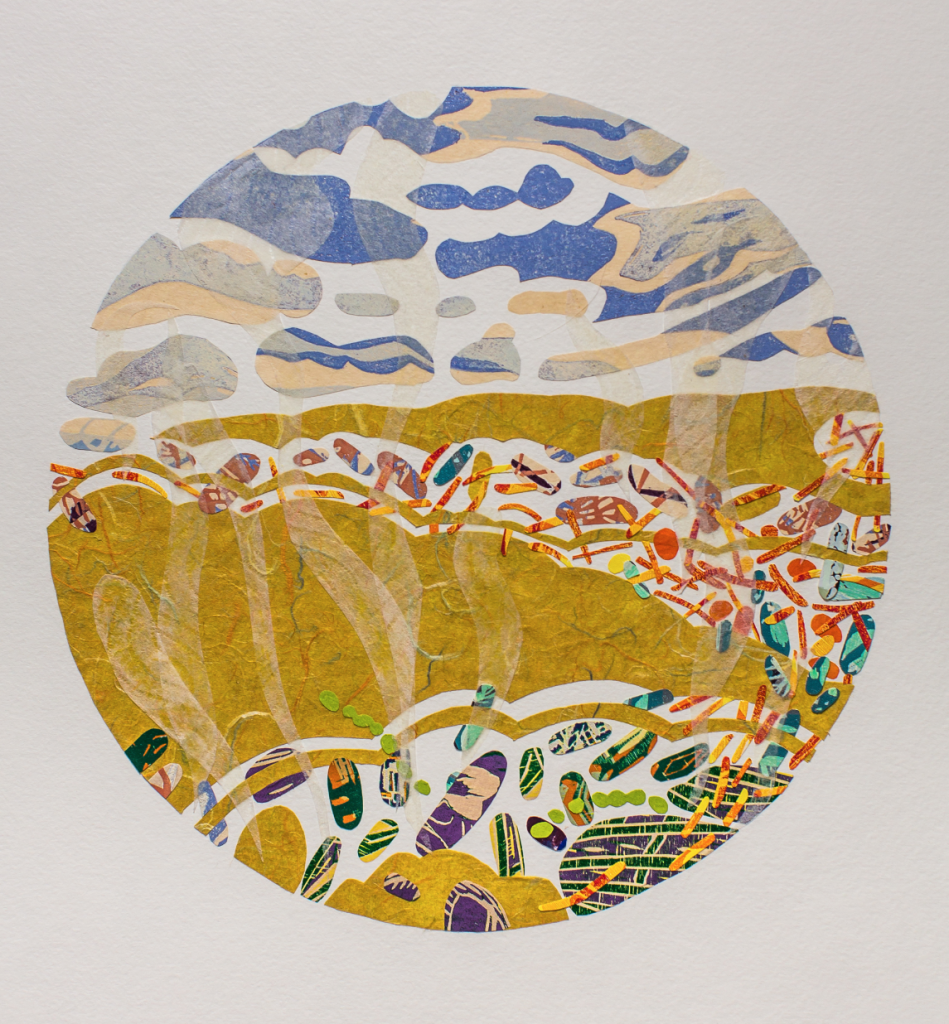
Impermafrost illustrates the potential for microbes to contribute to climate change as Arctic permafrost thaws. Permafrost is a layer of soil that remains frozen for at least two years and up to tens of thousands of years or more. Yet as temperatures rise in the Arctic, permafrost is thawing. As permafrost melts, it is possible that microbes could play a part in accelerating global warming. Because permafrost is frozen its organic matter does not break down, yet as it thaws, microbes break down the organic material. This is where the trouble begins. Arctic permafrost contains large quantities of carbon trapped in dead plants and animals. When microbes eat the organic matter trapped in the permafrost they produce carbon dioxide and sometimes methane, greenhouse gases that could cause temperatures to rise even more. This piece is my interpretation of this scenario.
Rust Spores and Hyphae
Rust Spores and Hyphae is an observational piece inspired by the microscopic happenings on the leaf of a wild rose bush. Throughout the course of this project I have been curious about the microbial worlds that flourish in association with the boreal forest flora. Trees, ground cover, leaves, and lichen are often the subjects of my art, so it felt natural to explore these subjects at the cellular level. Each summer I notice many of the wild rose bushes in the woods around my house develop masses of bright orange powdery spores, uredinia, on the stems, leaves, and rose hips. I took samples of these powdery spores and made both dry and wet mount slides to view under the microscope. The microscopic imagery was so rich. The lines and tangles of the glasslike strands of hyphae and clusters of orange spores were so full of action and beauty. Knowing what I was viewing added to the wonderment and informed the final piece.
Point of Entry
Point of Entry provides an intimate view of a tree by illustrating the cellular structure of wood as spores and fungal hyphae enter through a wound and then spread. Throughout the course of this collaboration I spent a lot of time looking at pictures and prepared slides of the cellular structure of plants. I am drawn to the aesthetic qualities of plants at the microscopic level. The patterns created by the cells and the variation among plant species provide much inspiration.
The wound or weak spot is so interesting to me. Just as a cut in your arm provides an entry point for unwanted invaders, a wound to the tree does the same thing. It is obvious and basic, yet interesting both visually and metaphorically.
Dr. Jane Wolken, Program Coordinator with the Alaska Climate Science Center, provided me with image-rich textbooks about wood science, answered numerous questions, and gave me practical tips for preparing slides with wood. We did not collaborate formally, but our conversations and her wealth of knowledge on the topic helped to strengthen my understanding and solidify my ideas.
Mycorrhizae
Of the many areas of microbiology I was exposed to throughout this collaboration, mycology, the study of fungi, has had the most significant impact on my work.
This piece is about symbiotic relationships and concepts of connectivity. Within the natural world there are so many examples of mutually beneficial partnerships between organisms. I see this as a model for humanity. The serigraph print, Mycorrhizae, illustrates the symbiotic association of the mycelium of a fungus with the roots of vascular plants and trees. Mycorrhizae are the symbiotic relationships that form between fungi and plants. The fungi colonize the roots of the plant providing increased water and nutrient absorption. In exchange, the plant provides the fungus with carbohydrates formed during photosynthesis. This system of interdependence is a beautiful example of nature modeling for us the value and necessity of working together.
A mushroom walk with the ITOC group on the UAF trails and another at Creamer’s Field, both led by Dr. Gary A. Laursen, provided me with a strong starting point for my own research and exploration. Dr. Laursen and his assistant, Christin Anderson, were able to explain so much about local fungi both above and below the surface.
Lichen
After spending months learning about microbial worlds and looking at imagery under the microscope, I felt challenged as to how to make art in response. Most of the work I do is visually inspired. I see something and respond to the colors and forms, looking again and again. Although I could look at the microscopic world through the microscope and at photographs of those views, the imperceptible microbial world was so unfamiliar to me. This painting of lichenised fungi allowed me to respond in the way I normally do when making art. It was the first piece I made for this show and acted as a gateway to making art about the microscopic world.
Lichen have traditionally been thought of as two organisms working together. The filamentous fungus acts as a protector from the environment, providing shelter and stability while the algae or cyanobacteria provide food through photosynthesis. The fungus benefits from the energy while the algae or cyanobacteria are protected. Recently, scientists found that lichen have a third partner, yeast, although their role is not yet understood. Together they are able to survive in places where they could not make it alone, they are a self-sufficient team. Lichen formation enables its partners to expand into habitats and environments they might not survive alone. The symbiotic associations within the microbial world are rich with metaphors for all life.
Sarah Tabbert
Sarah Tabbert
Printmaking and Carved Wood
saratabbert.com
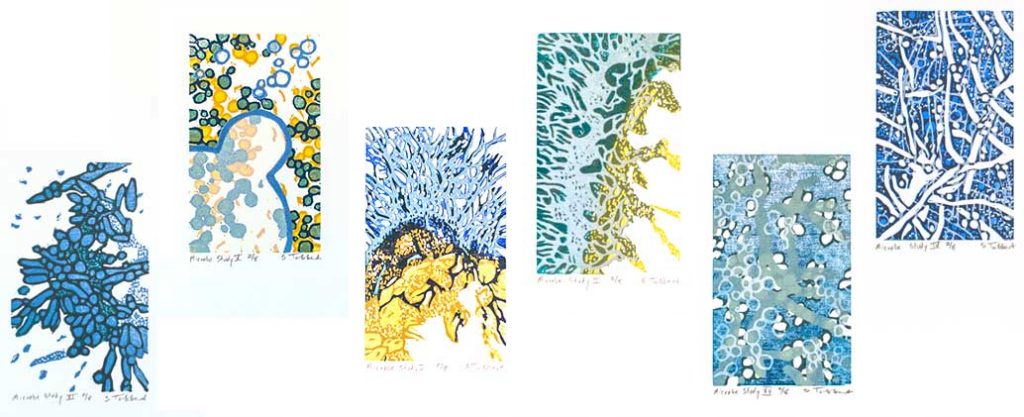 This project opened my eyes to a new world. Looking through the microscope felt akin to snorkeling. I put my head down and was suddenly transported to an entirely different place. The wide scope of our science presentations sent me in many directions. My ideas turned, and turned again, and finally after several magnificent detours returned more or less to the start.
This project opened my eyes to a new world. Looking through the microscope felt akin to snorkeling. I put my head down and was suddenly transported to an entirely different place. The wide scope of our science presentations sent me in many directions. My ideas turned, and turned again, and finally after several magnificent detours returned more or less to the start.
I struggled to photograph what I was seeing through the microscope and went looking for help. By the stumbling good fortune of the internet, I came upon the gorgeous photos by Eileen Rojas, a clinical mycologist in Seattle. Her humor, enthusiasm, and generosity helped my work enormously. Some of these pieces reference my own photographs and many are based on her images.
I read widely throughout the course of the past 16 months. For no particularly good reason I was most interested in infectious diseases. The Zika virus, the use of mosquitoes infected with bacteria to fight virus transmission, and several other topics were all contenders for my attention. Everything I looked at seemed to be affected by our changing climate in one way or another. Fungi are no exception. I could nerd away about increased problems brought on by more severe natural disasters or the advantages disease-causing fungi can gain over us mammals when they adapt to a warmer climate. What I understand now puts me barely at a dilettante’s level. Still, I am fascinated by the introduction.

